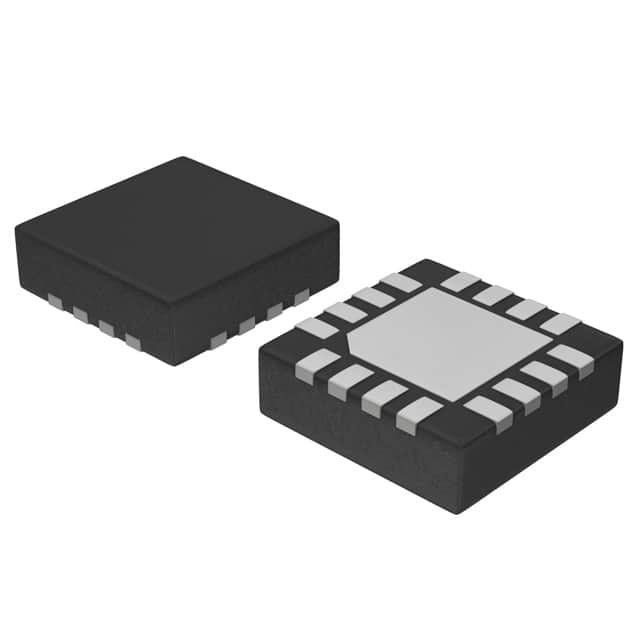NB6N239SMNR2
Overview
Category: Integrated Circuit
Use: Signal Conditioning and Clock Generation
Characteristics: High-speed, low-power, differential receiver
Package: 16-pin QFN
Essence: Signal conditioning and clock generation for high-speed data transmission
Packaging/Quantity: Tape and reel, 2500 units per reel
Specifications and Parameters
- Supply Voltage: 3.3V
- Input Voltage Range: -0.5V to VCC+0.5V
- Operating Temperature Range: -40°C to +85°C
- Output Type: Differential
- Maximum Data Rate: 4.25 Gbps
- Propagation Delay: 100 ps (typical)
- Power Dissipation: 150 mW (typical)
Pin Configuration
- VCC
- GND
- CLK+
- CLK-
- RIN+
- RIN-
- ROUT+
- ROUT-
- NC
- NC
- NC
- NC
- NC
- NC
- NC
- NC
Functional Characteristics
The NB6N239SMNR2 is a high-speed differential receiver designed for signal conditioning and clock generation in high-speed data transmission systems. It provides excellent signal integrity and noise immunity, making it suitable for demanding applications.
Key functional characteristics include:
- High-speed operation up to 4.25 Gbps
- Low power consumption
- Wide input voltage range
- Differential signaling for noise rejection
- Built-in termination resistors for simplified design
Advantages and Disadvantages
Advantages: - High-speed operation enables reliable data transmission - Low power consumption reduces energy requirements - Wide input voltage range allows compatibility with various signal levels - Differential signaling minimizes noise interference - Built-in termination resistors simplify circuit design
Disadvantages: - Limited pin configuration options - Not suitable for low-speed applications
Applicable Range of Products
The NB6N239SMNR2 is commonly used in the following applications:
- High-speed data communication systems
- Fiber optic networks
- Ethernet switches and routers
- Wireless base stations
- Test and measurement equipment
Working Principles
The NB6N239SMNR2 receives differential input signals and conditions them for further processing. It utilizes internal circuitry to amplify, filter, and synchronize the incoming signals, ensuring reliable data transmission. The differential output signals can then be used by downstream components for further processing or clock generation.
Detailed Application Field Plans
High-Speed Data Communication Systems: The NB6N239SMNR2 can be used in high-speed data communication systems to receive and condition incoming signals, ensuring accurate and reliable data transmission.
Fiber Optic Networks: In fiber optic networks, the NB6N239SMNR2 can be employed to receive and process optical signals converted into electrical signals, enabling seamless integration with other network components.
Ethernet Switches and Routers: By incorporating the NB6N239SMNR2, Ethernet switches and routers can enhance signal integrity and noise immunity, resulting in improved network performance.
Wireless Base Stations: The NB6N239SMNR2 can be utilized in wireless base stations to receive and condition incoming signals, facilitating efficient wireless communication.
Test and Measurement Equipment: Test and measurement equipment can benefit from the NB6N239SMNR2's high-speed operation and excellent signal conditioning capabilities, ensuring accurate measurements and reliable data analysis.
Detailed Alternative Models
NB6N14S: Similar to the NB6N239SMNR2, the NB6N14S is a high-speed differential receiver with comparable specifications and functional characteristics.
NB6N11S: The NB6N11S is another alternative model that offers differential signal conditioning and clock generation capabilities, suitable for high-speed data transmission applications.
NB6N15S: Designed for similar purposes, the NB6N15S provides differential signal conditioning and clock generation features, making it a viable alternative to the NB6N239SMNR2.
NB6N16S: The NB6N16S is a differential receiver with comparable characteristics, offering reliable signal conditioning and clock generation capabilities.
NB6N17S: Another alternative model, the NB6N17S, provides differential signal conditioning and clock generation functionalities, making it suitable for various high-speed applications.
5 Common Technical Questions and Answers
Q: What is the maximum data rate supported by the NB6N239SMNR2? A: The NB6N239SMNR2 supports a maximum data rate of 4.25 Gbps.
Q: Can the NB6N239SMNR2 operate at different supply voltages? A: No, the NB


